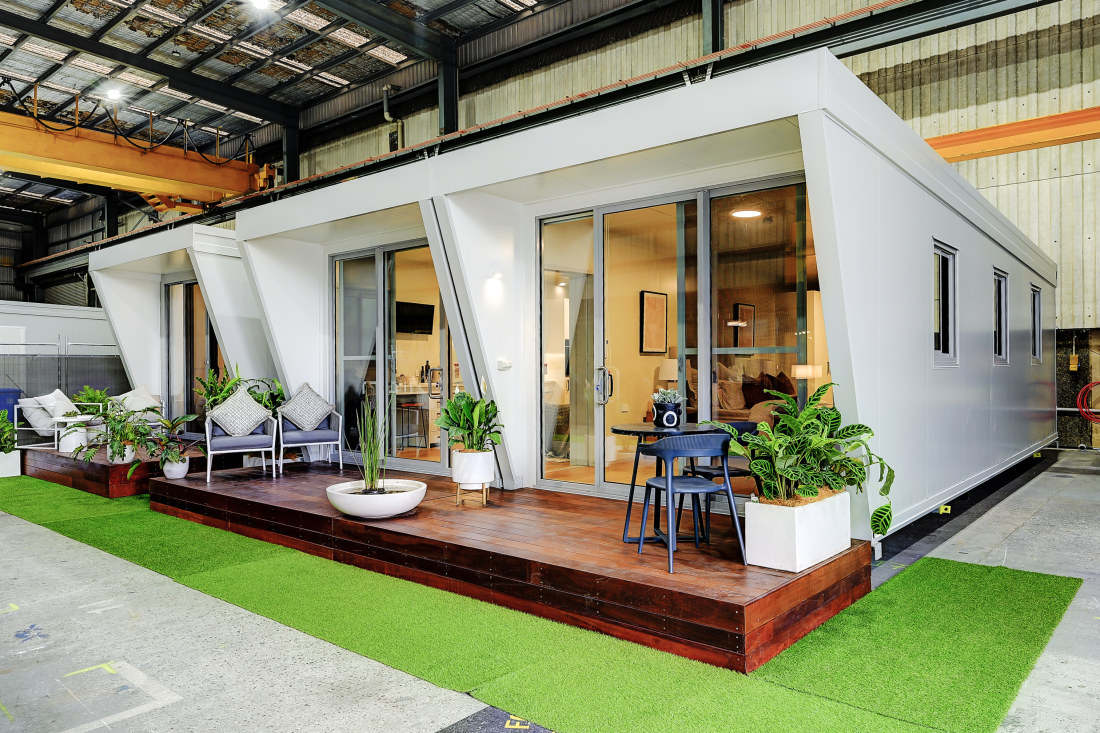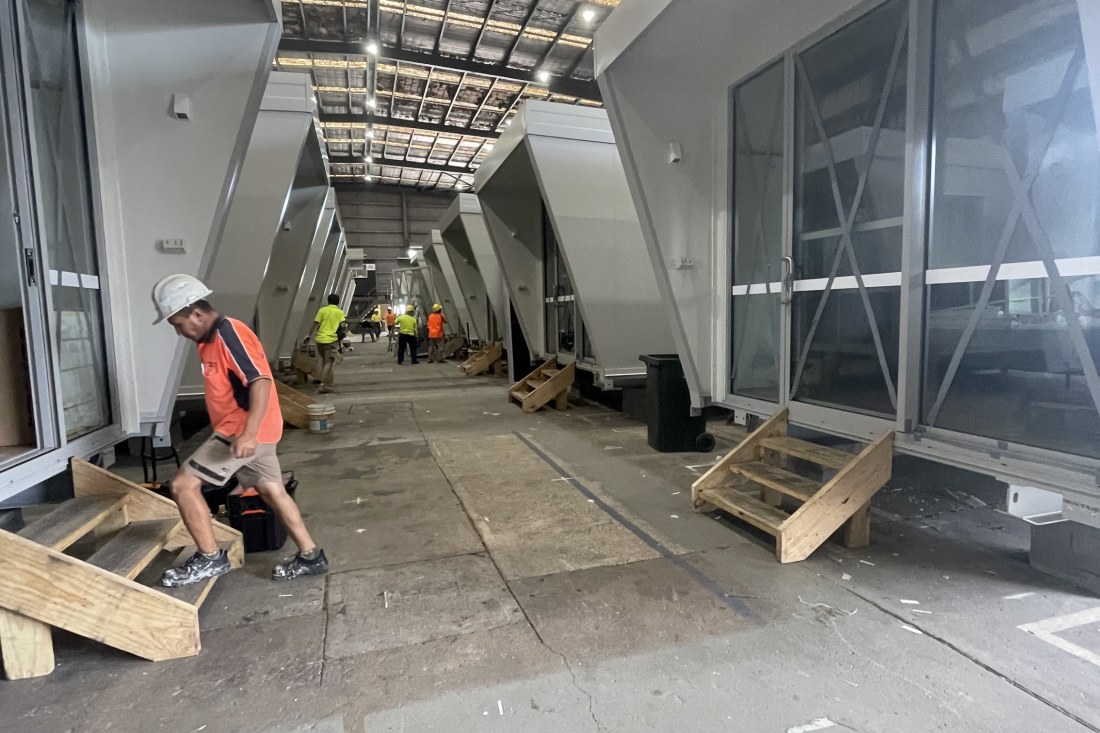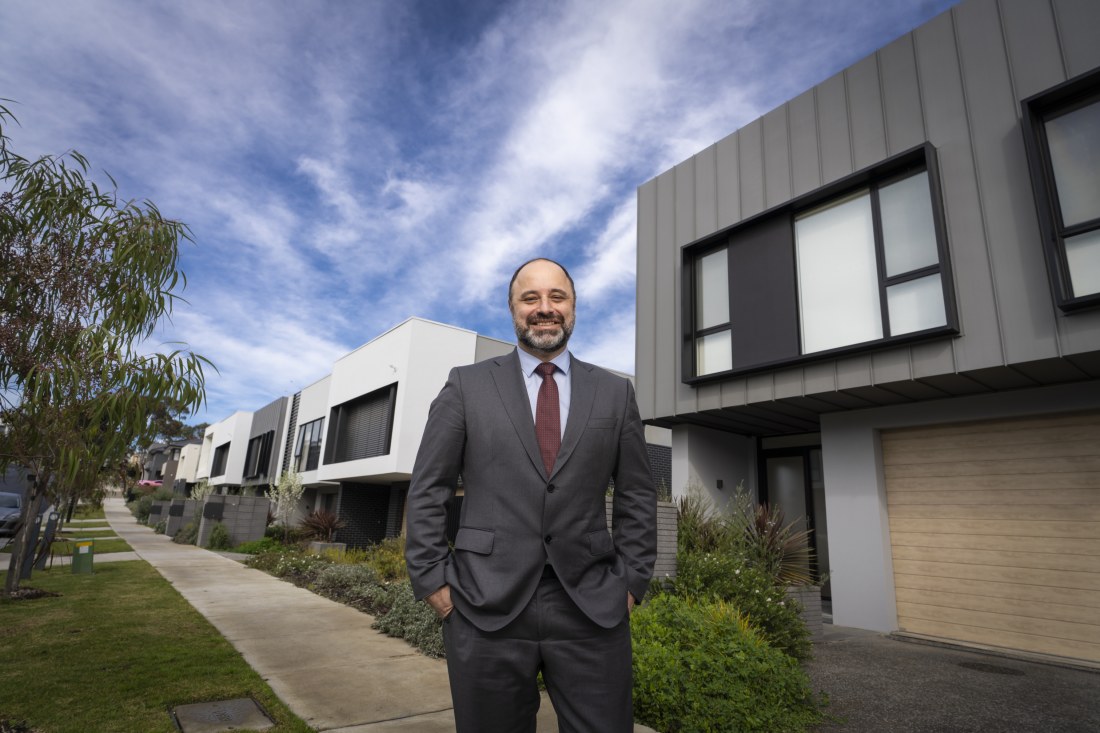Solving the worsening housing shortage
Merrilees believes factory-built housing will play a part in solving the country’s worsening housing crisis.
“A prefab modular home can be built in just 10 days, so we can get supply out more than twice as fast as the traditional build. We can also build multiple houses at the same time, so we can mass produce housing,” he says.

Wild Modular’s Sydney factory can build 18 homes concurrently at any given time.
Australia needs massive amounts of housing fast – in the order of 200,000 each year – just to keep up with demand from the population that is surging at historically high levels.
But with soaring construction costs, material shortages and a lack of skilled workers crippling the building industry, the housing supply pipeline has dwindled to alarming levels.
The National Housing Finance and Investment Corporation predicts that the housing shortfall will blow out by 106,300 between 2023 and 2027.
More critically, the rental market is in dire need of fresh supply right now to stem a rapid increases in rents, as vacancies fall to all-time lows fuelled by record migration.
“The housing need is urgent. But the ballooning housing shortfall is unlikely to be met using traditional construction methods,” says Professor Tuan Ngo, research director of the Australian Research Council Training Centre for Advanced Manufacturing in Prefabricated Housing at the University of Melbourne.
“I think prefab modular housing is a very obvious choice and probably one of the most viable options. If you’re looking to build homes fast, then you can’t rely on the traditional building method because they take much longer to build, the costs tend to blow out and delays are a common experience.”
Fast-build homes
Prefab modular homes are built in a factory rather than on site, so they require less labour than traditional homes. They are also built indoors, so they are not exposed to poor weather conditions and can be constructed more precisely and can be of higher quality.
A traditional build typically takes between nine and 12 months, while a prefab home can be built and ready within five to six months according to Prof Tuan.
“With better quality control and airtightness, prefab homes are also more energy efficient compared to the traditional home,” he says. “Maintenance costs can be up to 30 per cent lower, and construction waste can be reduced by up to 90 per cent.”

Wild Modular founders Alex Tattle and Tahi Merrilees at the Smithfield, Sydney, factory. Louie Douvis
There is also more certainty over cost as all the materials and components are worked in and guaranteed at the start of the process, says Damien Crough, executive chairman of prefabAUS, the peak body of Australia’s prefabrication industry.
“When you sign a contract with a modular manufacturer, they know exactly what they’re building because it’s manufactured, so they’re not making it up as they go, so there’s no cost blow outs,” he says.
On the flip side, the cost to build modular homes is more expensive by up to 15 per cent compared to the traditional build for residential homes according to Prof Tuan.
In addition, the prefab home may have to travel long distances to the site, which can be more expensive or lead to damage.
They are typically lifted off the truck and onto the foundation with a crane, sometimes with a helicopter, as Wild Modular does at times, which can also be costly.
Market size and forecast
Prefabricated modular construction, which has been around in Australia for more than 20 years, has been slower to get off the ground compared to Japan, Sweden and Germany, where it accounts for up 70 per cent of their respective construction industries.

The emergency accommodation Wild Modular built for the flood-hit Lismore residents.
The sector currently accounts for about 5 per cent of the $150 billion Australian construction industry, Crough says.
That share is expected to expand between 7 per cent and 15 per cent by 2025, creating 20,000 jobs and adding $30 billion to the Australian economy. By 2033 prefab is expected to gain 30 per cent of the building construction industry.
The sector has significantly evolved in the past decade, and has been used to build schools, aged care homes and accommodation for mining workers, Crough says.
However, residential demand is a small slice of the prefab sector, because of a perception problem.
“People still think that it is temporary, poor quality and cheap stuff, and in fairness, you can still buy that if you want, but the technology has evolved dramatically in the past 10 years and there are a lot of innovative designs emerging from manufacturers,” he says.
Mirvac Residential head Stuart Penklis says adopting prefab in building homes at scale is challenging, but also offers big opportunities for property developers.
Mirvac has been using prefabricated components in its projects in the past 10 years including bathrooms, but it still only accounts for about 15 per cent of their business at the moment.
“It’s still a small component, and it does fluctuate up and down depending on the projects, but we are very committed to ensuring it becomes a bigger component of not just our business, but also of the industry moving forward,” Penklis says.

Factory-built homes could help supply the housing market fast according to proponents of the sector.
“Adoption is certainly not smooth sailing as the cycle progresses. We’ve seen a number of headwinds from the perspective of labour and material shortages, which has meant that the viability of prefab has fluctuated through that period.
“At the same time, with the ongoing challenges with labour and supply chain, I think what we will see is a greater pivot towards more off-site construction and on-site assembly.“
So far, Mirvac has delivered about 200 homes through prefabrication over the past 10 years. More recently, it has built 45 homes using prefab in its Georges Cove development in Moorebank, 27 kilometres south-west of the Sydney CBD.
Using what Mirvac calls “modern methods of construction”, the company was able to reduce construction time by 54 per cent and the overall construction duration by 30 per cent. It also cut down waste produced onsite by half, or the equivalent of 10 dump trucks.
At its development in Tullamore in Melbourne’s Doncaster East, Mirvac slashed its build time by 23 per cent using prefabrication. It was also able to reduce labour cost by 11 per cent for townhouses in its pilot program.
Challenges remain
But the slow uptake by homebuyers remains a big challenge, Crough says.
“What we need is volume, scale and repetition, and what we call mass customisation, like what they’re doing in Japan, where Toyota builds 40,000 homes a year, and they build them on a production line very similar to how they would build cars,” he says.
“If we can give a manufacturer a committed pipeline of 20 or 30 homes a month with minimal variation, but all the homes being customised to the purchasers’ choice, then we are going to see a massive decrease in cost escalation, and we see a huge increase in productivity, and productivity is what brings cost savings over time.

Mirvac head of residential Stuart Penklis in front of newly built townhouses, some of which were prefab. Eamon Gallagher
“I think this predominantly needs to be underpinned or driven by the government in the affordable social housing space.”
There are signs that the potential of prefab is already being recognised by some state governments.
Jarn Gyrn, chief executive of Melbourne-based modular home manufacturer Modscape, has been working with the Queensland government to help ramp up prefab manufacturing in the state to build affordable housing quickly.
“The Queensland government, at a high level, has an aspiration to deliver 20,000 social and affordable housing products over the next five years, and they’re looking to deliver half of that using prefab technology, so they established a panel of providers and architects to design and create a catalogue of products that can be utilised for that program, and we’re part of that,” Gyrn says.
“We’ve recently started production on a number of the houses for that project, and it’s exciting because it is a great response to solving the housing crisis in the country.”
Last month the Queensland government opened the QBuild Rapid Accommodation and Apprenticeship Centre in Eagle Farm in Brisbane, where prefabricated homes will be built and then transported across the state. This is part of the state government’s $519.2 million Government Employee Housing construction package that will build 439 homes over the next five years to house 550 frontline workers.
Federal Assistant Trade Minister and Assistant Manufacturing Minister Tim Ayres says: “There’s no silver bullet to Australia’s housing challenges but bolstering industrial capability could be part of the answer.
“I’m interested in hearing more from the modular construction industry about ideas to deliver more industrial capability and in turn, more affordable homes for Australians.”
But the sector is also still saddled with regulations that hinder it from taking off, according to the Housing Industry Association, which has published a report examining the regulatory barriers to prefab construction last year.
The report found that given the likelihood of a steady increase in demand for fast-tracked building construction, a vast number of construction projects including housing will move to off-site and modular or systems-based construction methods over the next five, 10 and 20 years.
However, regulations relating to offsite construction methods, including prefab and modular remain vague, and are impeding the cost-effective and timely delivery of buildings, it says.
In addition, getting finance for small scale residential construction and for home buyers is also difficult as prefab is still not widely recognised by the banks.
“Australia’s regulatory systems need to be updated and revised to remove the unnecessary barriers and enable greater uptake and recognition of the suitability and effectiveness of prefabricated and modular construction and facilitate an appropriate and streamlined process for the necessary approvals,” HIA says.
